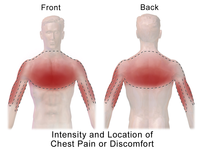
Photo from wikipedia
OBJECTIVES The goal of care at the end-of-life has changed in recent years to encompass not only the relief of suffering but also improve the quality of death. Palliative care… Click to show full abstract
OBJECTIVES The goal of care at the end-of-life has changed in recent years to encompass not only the relief of suffering but also improve the quality of death. Palliative care offers a coordinated and multidisciplinary approach to improving the quality of life and quality of care of individuals and their families facing illness at the end-of-life. This manuscript examines the end-of-life of older adults in Mexico and the factors associated with pain in this period of their life. STUDY DESIGN We used data from the Mexican Health and Aging Study (MHAS), a longitudinal panel study of adults 50 years and older in Mexico that is nationally representative of urban and rural areas and includes a next-of-kin questionnaire that captures the conditions during the last year of life of those who died. We used all four waves of data to construct a group of deceased individuals between 2001 and 2015, including information in the wave immediately before death and a complete next-of-kin questionnaire. We studied factors associated with pain at the end-of-life in this group. METHODS The dependent variable was pain reported over time among deceased individuals. We constructed pain categories based on whether the pain was reported in one or two waves (occasional and persistent), and the pain intensity reported (mild, moderate, or severe). We included independent variables previously reported to be related to pain, including sociodemographic, functional, and health characteristics. We used descriptive statistics and a multinomial regression model to examine the factors associated with pain in this group. RESULTS Pain was reported by 71.5% of older adults who died between 2001 and 2015. The prevalence of pain differed significantly by sociodemographic characteristics. Women had 1.69 higher odds of reporting severe pain than men. Compared to those with zero years of education, the odds of reporting severe pain were 0.72 for those with 1-6 years of education (P < 0.05) and 0.55 for those with more than 7 years (P < 0.001). Poor self-reported health, arthritis, taking more medications, depression, and functional limitations in the wave prior to death were associated with higher odds of persistent pain at the end-of-life (P < 0.05). Conversely, older age, more years of education, and diabetes were associated with lower odds of persistent pain (P < 0.001). CONCLUSIONS The prevalence of pain among older Mexican adults is high at the end-of-life. Sociodemographic factors, some chronic diseases, number of medications, psychosocial factors, and functional status impact the odds of reporting pain in this group at the end-of-life. Providing education to families on psychosocial interventions to improve the quality of care at the end-of-life is a pressing need in Mexico. These findings provide information to help policymakers and healthcare providers in Mexico improve the quality of care at the end-of-life.
Journal Title: Public health
Year Published: 2021
Link to full text (if available)
Share on Social Media: Sign Up to like & get
recommendations!